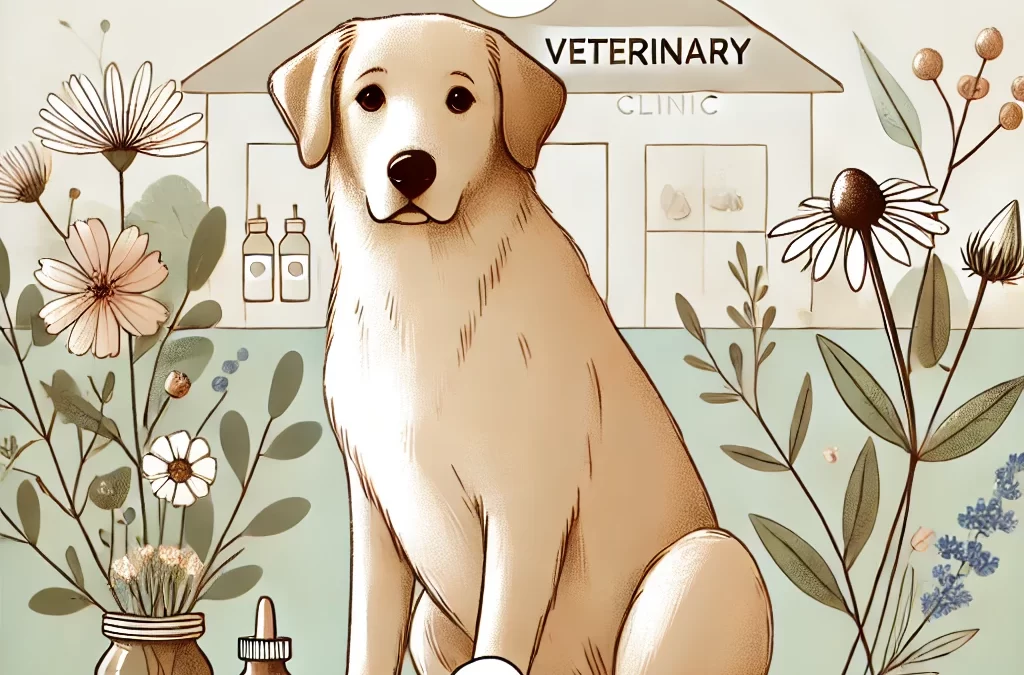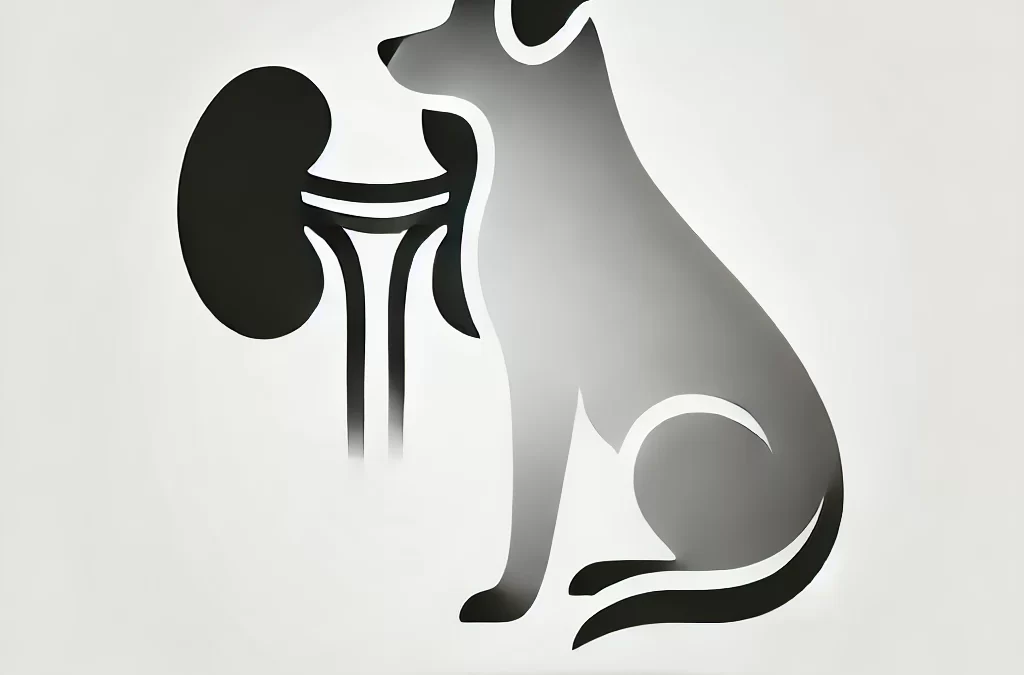
執筆者 TCMVET | 2024年12月3日 | 犬の癌と腫瘍
血管周皮腫は、血管を囲む細胞である周皮細胞から発生する、犬のまれな軟部組織腫瘍です。これらの腫瘍は一般的に成長が遅く局所的ですが、外科的切除後に再発する傾向があるため、獣医腫瘍学では独特の課題となっています。この記事では、血管周皮腫の性質、診断、および効果的な管理の画期的な方法について詳しく説明します。
犬の血管周皮腫とは何ですか?
血管周皮腫は、通常、中年から高齢の犬の皮膚または皮下組織に見られます。これらの腫瘍は、次のように現れることがあります。
- 皮膚の下の硬くて動くしこり
- 大きさは様々で、表面にある場合は潰瘍になることもある
- 進行は遅いが侵襲性の腫瘍
これらの腫瘍は、通常は四肢に発生し、転移することはめったにありませんが、犬の運動能力や快適性に大きな影響を与える可能性があります。
注意すべき珍しい兆候
血管周皮腫は最初は無害に思えるかもしれませんが、次のような特定の症状がある場合は注意が必要です。
- しこりを舐め続ける、または噛む
- 腫れが治まらない
- 局所的な跛行または不快感
これらの微妙な兆候は、腫瘍の成長を示すより明らかな兆候に先行することがよくあります。
診断への革新的なアプローチ
従来の診断方法では、穿刺吸引法または生検を行った後、X 線や超音波などの画像診断を行います。しかし、獣医診断の進歩により、現在では次のことが可能になっています。
- CTスキャン: 腫瘍の範囲の詳細な画像を提供します。
- 3D腫瘍モデリング: 正確な外科的介入を計画するために使用されます。
- 液体生検: 血流中の腫瘍特異的マーカーを検出し、非侵襲的なモニタリングを可能にする最先端の方法。
治療オプションの再考
血管周皮腫の治療では手術が依然として標準治療ですが、治療成績を向上させる革新的な方法も登場しています。
- 高度な外科手術技術レーザー手術と電気手術により、よりきれいなマージンが実現し、再発のリスクが軽減されます。
- 免疫療法: 手術後に残存する癌細胞を標的として免疫系を刺激します。
- 凍結療法: 手術が不可能な場合に、局所的な制御のために腫瘍細胞を凍結します。
- 光線力学療法光活性化薬剤を使用して癌細胞を破壊します。
これらの新しいアプローチは、従来の手術が困難であったり不十分であったりするケースに代替手段を提供します。
自然療法と補助療法
ホリスティックケアは、従来の治療法を補完するものとして注目を集めています。これには次のようなものが含まれます。
- ハーブサプリメント: 黄耆や薬用キノコなどの成分は免疫力を高め、腫瘍の成長を抑制する可能性があります。
- 鍼治療: 痛みを和らげ、全体的な健康状態を改善します。
- CBDオイル: 抗炎症作用と鎮痛作用で知られており、犬の不快感を和らげるのに役立ちます。
これらの療法は、適切な栄養と定期的な運動と組み合わせることで、生活の質の向上に貢献します。
緩和ケアの力
進行性または再発性血管周皮腫を患う犬の場合、緩和ケアは快適さに重点を置きます。
- 薬物療法またはレーザー療法による疼痛管理
- ハーネスや車椅子などの移動補助具
- 精神的健康を維持するための感情の豊かさ
飼い主は、困難な時期にペットに愛情とケアを与えていることを知ることで、慰めを見出すことがよくあります。
血管周皮腫がイノベーションの呼び水となる理由
血管周皮腫は、獣医師とペットの飼い主の両方に、従来の治療法を超えた考え方を要求します。転移の可能性が低いため、犬の生活の質を損なうことなく、標的療法と総合的なアプローチを試す絶好の機会となります。
新しい技術と統合的なケアを取り入れることで、血管周皮腫の管理はより個別化された効果的なプロセスへと進化し、犬に快適で充実した生活を送る最高のチャンスを与えることができます。

執筆者 TCMVET | 2024年12月3日 | 犬の癌と腫瘍
犬の脊椎がんは、まれではありますが、背骨や脊髄に影響を及ぼし、衰弱症状を引き起こす可能性のある重大な病気です。従来の獣医学的アプローチには、手術、放射線療法、化学療法が含まれることが多いですが、生活の質を優先する統合的自然療法への動きが高まっています。この記事では、犬の脊椎がん特有の課題について検討し、管理に関する代替的な視点を紹介します。
犬の脊椎癌とは何ですか?
脊椎がんは、脊椎内で異常な細胞が制御不能に増殖し、骨、神経、または周囲の組織に影響を及ぼすことで発生します。一般的な種類は次のとおりです。
- 骨肉腫: 脊椎の骨に影響を及ぼします。
- リンパ腫: 脊髄または椎骨に浸潤する可能性があります。
- 腫瘍脊髄や神経を圧迫する腫瘍。
これらの腫瘍は、発生場所に応じて、痛み、歩行困難、麻痺、失禁などを引き起こす可能性があります。
注意すべき珍しい症状
脊椎がんの初期症状はわかりにくいことが多く、他の病状と似ていることがあります。
- 歩行中に体重を移動したり、片側に傾けたりする
- 背中を反らせるなどの姿勢の変化
- 背骨に沿った触覚に対する敏感さ
これらの指標は決定的なものではありませんが、直ちに獣医の診察を受ける必要があります。
診断と予後を再考する
X 線、MRI、生検などの従来の診断方法では、脊椎がんの存在を確認できますが、侵襲性が高く、費用もかかります。場合によっては予後が厳しいこともあり、多くのペットの飼い主は、侵襲性が低く、より総合的なアプローチを求めています。犬の特定の状態、全体的な健康状態、生活の質を理解することは、今後の最善の道を決定する上で不可欠です。
統合的かつ自然なアプローチ
従来の治療法を補完または代替することを検討しているペットの飼い主や獣医師の間では、革新的なアプローチが注目を集めています。これには次のようなものがあります。
- 鍼治療: 痛みを管理し、神経機能を改善します。
- ハーブ療法: ターメリックやボスウェリアなどの成分は炎症を軽減し、腫瘍の成長を遅らせる可能性があります。
- CBDオイル: 鎮痛・抗炎症作用で人気が高まっています。
適切な栄養、適度な運動、ストレスのない環境と組み合わせることで、これらの療法は犬の快適さと健康を大幅に向上させることができます。
緩和ケアの力
進行した脊椎がんを患う犬の場合、緩和ケアは病気を治すことよりも症状の管理に重点を置きます。これには以下のものが含まれます。
- 痛みや炎症を軽減する薬
- 運動機能を改善するための理学療法
- ペットとの強い絆を維持するための感情的なサポート
多くのペットの飼い主は、積極的な治療よりも快適さを優先することで、愛犬たちのより幸せで平穏な生活につながることに気づいています。
脊椎がんの犬たちへの希望
脊椎がんの診断は気が重いものですが、希望がなくなるわけではありません。代替療法を検討し、生活の質に重点を置くことで、飼い主は愛犬にふさわしい愛情とケアを与えることができます。犬の歩みはそれぞれ異なり、思慮深いアプローチが大きな違いを生む可能性があります。
執筆者 TCMVET | 2024年12月2日 | 犬の癌と腫瘍
骨肉腫は犬によく見られるが進行性の骨癌で、激しい痛みや足の不自由を伴うことがよくあります。しかし、呼吸困難はあまり話題に上らない症状で、進行した症例で現れることがあり、多くの飼い主を困惑させ、心配させています。この記事では、骨肉腫を患う犬の呼吸困難の潜在的な原因を探り、この厄介な症状を管理するための指針を示します。
呼吸が荒くなるのはなぜですか?
骨肉腫を患う犬は、次のようないくつかの理由で激しい呼吸を経験することがあります。
1. 痛みと不快感
骨肉腫は、特に腫瘍が増殖したり転移したりすると、痛みを伴う病気です。痛みにより、身体がストレスに対処しようとして呼吸数が増加することがあります。このような状況で激しい呼吸をすることは、不快感の兆候であることが多いです。
2. 肺への転移
進行した段階では、骨肉腫は肺に転移することがよくあります。肺転移は、肺容量と酸素交換の減少により、呼吸困難、咳、喘鳴を引き起こす可能性があります。
3. 鎮痛剤の副作用
骨肉腫を患う犬の多くには、オピオイドや非ステロイド性抗炎症薬 (NSAID) などの鎮痛薬が処方されます。これらの薬は必要なものですが、呼吸パターンに影響を及ぼすことがあります。
4. 不安やストレス
慢性的な痛みや病気による精神的影響により、犬は不安になり、ハアハアと息をしたり、呼吸が荒くなったりすることがあります。犬は呼吸によって苦痛を伝えることがよくあります。
5. 二次的合併症
胸水(肺の周りの液体)や慢性疾患による貧血などの症状も呼吸困難の原因となることがあります。どちらの問題も、骨肉腫またはその治療の二次的合併症として発生することがあります。
心配すべきとき
激しい呼吸は、特に以下の症状を伴う場合には無視してはいけません。
- 無気力または動きたくない気持ち。
- 咳や喘鳴。
- 歯茎や舌が青みがかっている場合は、酸素レベルが低いことを示しています。
- 全体的な健康状態の急速な悪化。
これらの症状は、獣医による緊急の介入が必要であることを示している可能性があります。
助けるために何ができるでしょうか?
1. 疼痛管理
効果的な痛みのコントロールが不可欠です。不快感を軽減するために、薬の調整や鍼治療、CBD オイルなどの代替療法の導入について獣医師に相談してください。
2. 酸素療法
肺転移や胸水の場合は、酸素補給によって呼吸が楽になります。携帯型酸素室やクリニックでの治療で症状が緩和されることもあります。
3. ストレスレベルを監視する
犬のために穏やかで快適な環境を作りましょう。優しいマッサージ、鎮静フェロモン、処方された抗不安薬などを使ってストレスを軽減しましょう。
4. 緩和ケア
犬の状態が進行している場合、緩和ケアでは生活の質の維持に重点が置かれることがあります。これには、積極的な治療ではなく、症状の管理が含まれる場合があります。
5. 獣医による評価
激しい呼吸が続く、または悪化する場合は、必ず獣医に相談してください。胸部X線検査や血液検査などの診断検査は、根本的な原因を特定するのに役立ちます。
A Compassionate Approach
骨肉腫にかかった犬の激しい呼吸は、この病気がもたらす肉体的、精神的負担を思い起こさせます。この病気の管理は困難ですが、医療、愛情、注意深さを組み合わせることで、安心感を得ることができます。常に獣医師と緊密に協力し、犬の健康のために最善の決定を下してください。
激しい呼吸にすぐに気づいて対処することで、最も困難な時期であっても、愛犬がサポートされ、世話をされていると感じられるようになります。

執筆者 TCMVET | 2024年12月2日 | 犬の癌と腫瘍
犬の腎臓がんは比較的まれな病気ですが、その微妙な症状は他の病気と間違われることが多く、重要な治療が遅れることがあります。この記事では、このサイレント疾患のあまり知られていない兆候について詳しく取り上げ、手遅れになる前に犬の飼い主が潜在的な問題を特定できるようにします。
稀ではあるが深刻な症状
腎臓がんは犬のがん全体の 1% 未満を占めますが、犬の健康に深刻な影響を及ぼす可能性があります。高齢犬が罹患することが多いですが、どの犬種も罹患しません。目に見える腫瘍や明らかな症状のあるがんとは異なり、腎臓がんは進行段階に達するまで隠れたままになることがよくあります。
症状を明らかにする
ペットの飼い主が見逃しがちな腎臓がんの意外な症状をいくつかご紹介します。
1. 喉の渇きと排尿の増加(多飲多尿)
最も初期の兆候の 1 つは、喉の渇きや排尿過多ですが、これは老化や腎臓感染症の兆候として無視されることが多いです。しかし、これらの症状は、腫瘍が原因で腎臓が機能不全に陥っていることを示している可能性があります。
2. 尿に血が混じる(血尿)
赤色またはピンク色がかった尿が見つかると、不安になります。血尿は腎臓がんを含む腎臓の問題の危険信号です。出血は出たり止まったりするため、何気なく観察しているだけでは見逃されやすいです。
3. 原因不明の体重減少
食事や活動量に変化がないのに体重が減っている犬は、腎臓がんの全身的影響を受けている可能性があります。腫瘍は食欲と栄養吸収を妨げ、徐々に体重が減る原因となります。
4. 腹部の腫れ
腹部の腫れや触知できる塊は、より進行した症状です。飼い主は、犬の腹部がいつもより硬くなったり大きくなったりしていることに気づくかもしれません。
5. エネルギーレベルの低下
無気力は、腎臓がんを含む多くの病気に共通する非特異的な症状です。この症状のある犬は、活動性や遊びへの熱意が著しく低下することがあります。
6. 嘔吐と消化器系の問題
腎臓が毒素を効果的に濾過できなくなると、嘔吐、吐き気、下痢などの胃腸症状が現れることがあります。これらの症状は時間の経過とともに悪化する可能性があります。
7. 呼吸困難
稀に、腎臓がんが肺に転移し、呼吸困難や咳を引き起こすことがあります。
早期発見が重要な理由
腎臓がんの犬の転帰を改善するには、早期診断が重要です。病気が早期に発見された場合、影響を受けた腎臓を除去する手術(腎摘出術)、化学療法、または総合的アプローチなどの治療がより効果的になります。
ペットの飼い主は何ができるでしょうか?
1. 定期的な獣医の診察
定期的な健康診断により、気づかれないかもしれない異常を発見することができます。徹底的な身体検査と血液検査および尿検査を組み合わせることで、腎臓の健康に関する早期の手がかりを得ることができます。
2. 犬の標準を知る
犬の行動、食欲、排尿習慣の微妙な変化を観察することは、命を救うことにつながります。健康日記をつけることで、異常な症状を長期にわたって追跡することができます。
3. 診断ツールを活用する
腎臓がんが疑われる場合は、超音波、X 線、CT スキャンなどの高度な診断ツールで腫瘍の存在を確認し、治療を導くことができます。
希望に満ちた未来
腎臓がんは深刻な診断ですが、獣医学の進歩により希望が生まれています。従来の治療法に加え、ハーブサプリメントや食事の変更などの補完療法を検討して、犬の健康全般をサポートする飼い主もいます。
終わりに
犬の腎臓がんはまれかもしれませんが、その症状を理解することで命を救うことができます。飼い主は情報に通じて注意を怠らないことで、愛犬がより健康で長生きできるようにすることができます。これらの兆候に気づいたら、ためらわずにすぐに獣医に相談してください。早期の行動が、この静かな病気に対する最善の防御策です。

執筆者 TCMVET | 2024年11月30日 | 犬の癌と腫瘍
愛犬にとって、乳腺腫瘤の診断ほど悲痛なことはありません。「腫瘤」という言葉を聞くと、癌や侵襲的な治療を連想し、恐怖を感じます。しかし、犬の乳腺腫瘤除去に外科手術以上のものがあったらどうでしょうか。治癒プロセスに腫瘤除去という物理的な行為だけでなく、真の健康を促進する総合的かつ総合的なアプローチも含まれるとしたらどうでしょうか。
この記事では、乳腺腫瘤除去法がどのように進化し、従来の獣医学の限界を押し広げて、この症状に悩む犬に包括的な解決策を提供しているかを探ります。
乳腺腫瘤の謎:基礎を理解する
乳腺腫瘤はメスの犬、特に避妊手術を受けていない犬に比較的よく見られます。腫瘤の多くは良性ですが、中には悪性の腫瘤もあり、がんの懸念が高まります。実際、犬の乳腺腫瘍の約 50% はがん性であり、早期発見と迅速な治療が不可欠です。
従来、乳腺腫瘤の主な治療法は外科的切除であり、腫瘤が悪性であることが判明した場合は、化学療法または放射線療法が続くことが多い。この治療法は今でも広く使用されているが、代替療法や補完療法への関心が高まるにつれて、治療の範囲は拡大している。
手術:基礎であり、完全な解決策ではない
外科的切除は、乳房腫瘤治療の基本です。その目的は、腫瘤を完全に切除し、癌の拡散リスクを減らすことです。しかし、手術だけでは長期的な健康は保証されません。本当の治療は、切開部が治癒してから始まるのです。
ここで統合的なアプローチが役立ちます。
ホリスティックケアの統合:予防とサポートの力
手術は当面の身体的な問題に対処しますが、多くの犬の飼い主が今や気づいているのは、術後のケアが再発を遅らせ、全体的な健康を促進するのに同様に重要であるということです。食事、ライフスタイル、自然療法の役割は、回復の不可欠な要素として最前線に浮上しつつあります。
1. 食事と栄養:体の防御力を高める
手術後は、バランスの取れた食事が重要になります。研究によると、特定の栄養素は免疫機能をサポートし、がん細胞と戦うのに役立つことが示唆されています。オメガ 3 脂肪酸 (魚油に含まれる) には抗炎症作用があり、抗酸化物質 (ビタミン C や E など) は健康な細胞を酸化ストレスから保護します。
専門家の中には、乳腺腫瘍の病歴がある犬には生食や抗がん食を勧める人もいます。これらの食事は、犬の免疫システムを強化し、炎症を軽減するのに役立つ赤身の肉、野菜、ハーブを重視しています。
2. ハーブサプリメントと自然療法:ホリスティックなアプローチ
従来の治療法に加えて、多くのホリスティック獣医師は治癒を助けるハーブサプリメントを推奨しています。アダプトゲンハーブには次のようなものがあります。 アシュワガンダ または ターメリック 抗炎症作用と免疫力を高める作用があることで知られています。さらに、亜麻の種子に含まれるリグナンは、がん細胞の増殖を抑制する可能性があることから推奨されることが多いです。
これらの自然療法は、伝統的な治療法と併用することで、体のシステムのバランスを整え、全体的な活力を高めるのに役立ちます。
3. 心と体のつながり:ストレス軽減と感情の癒し
犬の感情的な健康は、治癒の過程で過小評価されるべきではありません。ストレス、不安、否定的な感情が病気からの回復能力に影響を与えるという考えを裏付ける研究が増えています。十分な休息と愛情を込めた穏やかで愛情あふれる環境を提供することで、犬のストレス レベルが軽減され、より効果的に体が治癒します。
マッサージ療法、軽い運動、さらには犬の鍼治療も、血行を促進し、痛みを軽減し、回復中の全体的な健康を促進する方法として研究されています。
早期発見と積極的なケア:予防が鍵
将来の乳腺腫瘤や再発の予防は、早期発見にかかっています。定期的な獣医の診察と、定期的な乳腺検査(トリミング中または獣医の診察中)は、異常を早期に発見するのに役立ちます。避妊手術を受けていない、または以前に腫瘍があったなど、リスクの高い犬の場合、飼い主は乳腺の変化に注意深く、積極的に対処する必要があります。
さらに、最初の発情期の前に避妊手術を行うと、犬の乳腺腫瘍のリスクが軽減されることが示されており、ペットの飼い主にとって重要な考慮事項となっています。
次は何か?乳腺腫瘤治療の未来
獣医学の進歩に伴い、乳腺腫瘤の除去に対するアプローチはますます多面的になっています。手術は依然として重要な手段ですが、もはや治療の唯一の焦点ではありません。ホリスティックケアの実践、早期発見、予防策を統合することで、乳腺腫瘤と闘い、犬の全体的な健康を促進するためのより包括的な戦略が実現します。
体と心の両方を育む包括的なアプローチを採用することで、私たちの愛犬が乳腺腫瘤の除去後も長く健康で幸せな生活を送る可能性が高まります。
重要なポイント
- 手術は依然として不可欠 乳腺腫瘤の除去には手術が効果的ですが、その後は支持療法を続ける必要があります。
- ダイエット 抗炎症作用と免疫力を高める作用のある食品は治癒プロセスを助けるため、回復には極めて重要な役割を果たします。
- ホリスティック療法漢方薬や鍼治療などの治療法は、回復と全体的な健康を高めることができます。
- ストレス軽減 そして感情的な幸福は治癒プロセスの重要な要素です。
- 早期発見と避妊手術 将来的に乳腺腫瘤や乳がんを予防するためには非常に重要です。
メスの先を考え、総合的なアプローチを採用することで、私たちは犬たちに回復の最高のチャンスを与えるだけでなく、より豊かで充実した生活への道も与えます。




